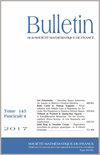棕榈树的种植,保护濒危物种Apterograeffea reunionensis Cliquennois & Brock, 2002 (Phasmatodea, Phasmatidae)
IF 0.6
4区 数学
Q3 MATHEMATICS
引用次数: 0
摘要
棕榈种植园,一个保护极度濒危的竹节虫Apterograeffea reunionensis Cliquennois & Brock的机会,2002年(竹节虫科,竹节虫科)。Apterograeffea reunionensis Cliquennois & Brock, 2002,是La r本文章由计算机程序翻译,如有差异,请以英文原文为准。
La culture des palmiers, un espoir pour la conservation du phasme menacé Apterograeffea reunionensis Cliquennois & Brock, 2002 (Phasmatodea, Phasmatidae)
Palm plantations, an opportunity for the conservation of the critically endangered stick insect Apterograeffea reunionensis Cliquennois & Brock, 2002 (Phasmatodea, Phasmatidae). Apterograeffea reunionensis Cliquennois & Brock, 2002, is an endemic stick insect of La Réunion, endangered due to the disappearance of its biotope and the over-harvesting of its host plants, the indigenous palms of La Réunion. Twenty years after A. reunionensis was described, we carried out a range of surveying over a 21 km2 area including the type locality. Today, the study area encompasses several plantations of palms which are host plants for the stick insect. We found out that the plantations which were in direct contact with the relict forest sheltered populations of A. reunionensis. On the contrary, the farthest plantations did not show any sign of the presence of the stick insect. In the study area, the observed distribution of A. reunionensis does not show significant distinctions to the estimated distribution at the time of the description of the stick insect. However, the observation of the distribution of the stick insect on some plots allows us to detect an active progression of its distribution at the scale of the study area, albeit at a slow pace. Years of over-harvesting of palms led A. reunionensis to the brink of extinction. Today, an economy based on the cultivation of indigenous palms provides us with the hope of the preservation of this endemic stick insect of La Réunion.
求助全文
通过发布文献求助,成功后即可免费获取论文全文。
去求助
来源期刊
CiteScore
0.90
自引率
0.00%
发文量
0
审稿时长
>12 weeks
期刊介绍:
The Bulletin de la Société Mathématique de France was founded in 1873, and it has published works by some of the most prestigious mathematicians, including for example H. Poincaré, E. Borel, E. Cartan, A. Grothendieck and J. Leray. It continues to be a journal of the highest mathematical quality, using a rigorous refereeing process, as well as a discerning selection procedure. Its editorial board members have diverse specializations in mathematics, ensuring that articles in all areas of mathematics are considered. Promising work by young authors is encouraged.

 求助内容:
求助内容: 应助结果提醒方式:
应助结果提醒方式:


